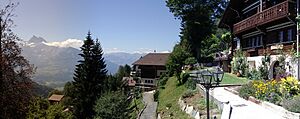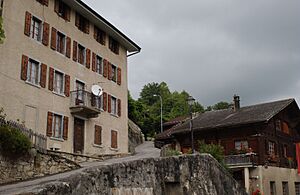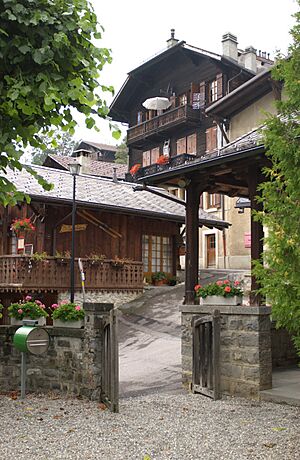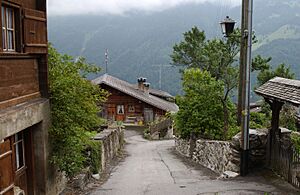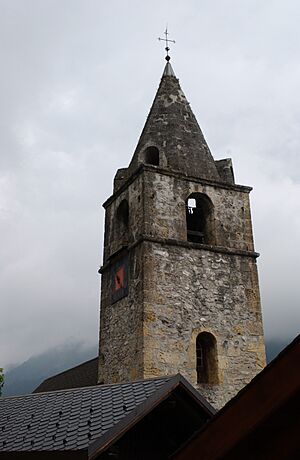Gryon facts for kids
Quick facts for kids
Gryon
|
||
|---|---|---|

Gryon village
|
||
|
||
| Country | Switzerland | |
| Canton | Vaud | |
| District | Aigle | |
| Area | ||
| • Total | 15.22 km2 (5.88 sq mi) | |
| Elevation | 1,114 m (3,655 ft) | |
| Population
(Dec 2020 )
|
||
| • Total | 1,376 | |
| • Density | 90.41/km2 (234.15/sq mi) | |
| Demonym(s) | Les Tachis | |
| Postal code |
1882
|
|
| Localities | La Barboleusaz, Les Pars | |
| Surrounded by | Ollon, Ormont-Dessus, Bex | |
Gryon is a charming village located in the canton of Vaud in Switzerland. It's a municipality found in the beautiful Aigle district.
Contents
Gryon's History
Gryon has a long history! It was first mentioned in official records way back in 1189. Back then, it was known as Griuns.
Exploring Gryon's Geography
Gryon covers an area of about 15.22 square kilometers (5.88 sq mi). A big part of this land, about 28.3%, is used for farming. Even more, about 52.3%, is covered by forests.
Around 11.2% of Gryon's land has buildings or roads. A small part, 0.5%, is rivers or lakes. The remaining 7.8% is land that isn't used for farming or building.
The village sits on a narrow, flat area about 1,110 m (3,640 ft) high. It's located between two deep valleys, called canyons, formed by the Gryonne and Avançon rivers. To the east, you'll find hillside villages like Les Chaux and La Barboleusaz. In the north, there are forests and the Taveyanne alpine pasture.
Gryon's Coat of Arms
Every town has a special symbol, and Gryon's is its coat of arms. The design shows a red shield with a silver cross. Below the cross, there are two silver axes with gold handles, crossed over each other. This design is called Gules, under a Cross Bottony Argent two Axes of the same handled Or in saltire.
People and Population in Gryon
Gryon has a population of 1,376 people. Over the past ten years (1999–2009), the number of people living here has grown by about 15.2%. This growth is mostly because people have moved into Gryon.
Most people in Gryon speak French, about 87.6% of the population. The next most common language is German, spoken by about 4.0% of residents. About 3.2% of people speak English.
Many people living in Gryon were born there or in the same canton. About 28.2% were born in Gryon, and 31.2% were born in the same canton. About 22.7% of the population were born outside of Switzerland.
The age groups in Gryon are quite varied. About 11.2% of the population are children aged 0-9 years old. Teenagers (10-19 years old) make up about 9.9%. Adults aged 20-59 make up a larger portion, and about 27.5% of the population are seniors aged 60 and older.
Most households in Gryon have about 2.1 people. In 2000, there were 459 private homes. About 37.4% of these homes had only one person living in them.
The historical population of Gryon is shown in this chart:

Important Sights in Gryon
The entire village of Gryon, along with the Taveyanne area, is very special. It's recognized as part of the Inventory of Swiss Heritage Sites. This means these places are important for their history and beauty in Switzerland.
Gryon's Economy and Jobs
In Gryon, many people work in different areas. In 2008, there were 19 people working in the primary sector, which includes farming. The secondary sector, which involves making things and construction, employed 92 people.
The biggest group of workers, 204 people, were in the tertiary sector. This sector includes jobs like sales, hotels, restaurants, education, and healthcare. For example, many people work in hotels or restaurants (22.2% of tertiary jobs). About 17.9% work in education, and 11.1% work in healthcare.
Many residents of Gryon travel to other towns for work. In 2000, 256 workers commuted away from Gryon, while only 53 came into the municipality for work. Most people (65.3%) use a private car to get to work, while 11.8% use public transportation.
Religion in Gryon
In 2000, most people in Gryon belonged to one of two main Christian groups. About 52.8% were part of the Swiss Reformed Church. Another 25.6% were Roman Catholic.
A smaller number of people belonged to other Christian churches, or to the Islamic faith. About 15.4% of the population did not belong to any church, or were agnostic or atheist.
Gryon's Weather
Gryon experiences about 139.4 days of rain or snow each year. On average, it receives about 1,367 mm (53.8 in) of precipitation.
The wettest month is June, with an average of 134 mm (5.3 in) of rain or snow over 13.9 days. May also has many days of precipitation (13.9 days), but with slightly less rain. The driest month is October, with about 94 mm (3.7 in) of precipitation over 9 days.
Education in Gryon
Education is important in Gryon. About 39.0% of the population has finished non-mandatory upper secondary education. Also, 16.1% have completed higher education, like attending a university.
In the 2009/2010 school year, there were 111 students in the Gryon school district. The local school system provides two years of optional pre-school. There were 70 students in primary school (which lasts four years). For middle school (lower secondary school), which lasts six years, there were 41 students.
Some students from Gryon attend schools outside the municipality. In 2000, 83 residents went to schools in other towns.
See also
 In Spanish: Gryon para niños
In Spanish: Gryon para niños





